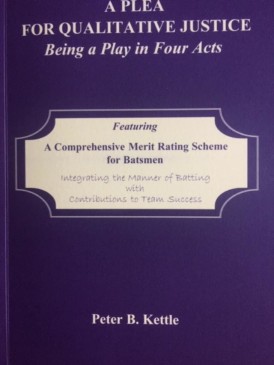A Plea for Qualitative Justice
Dave Wilson |Published: 2019
Pages: 76
Author: Kettle, Peter
Publisher: Peter Kettle Associates
Rating: 4 stars

As with Peter Kettle’s earlier book Rescuing Don Bradman from Splendid Isolation , the subject of this review A Plea for Qualitative Justice was also previously reviewed by CW’s Martin Chandler. As with the earlier book, Martin considered that it would be a good idea for me to also review this book.
Martin’s review concluded with the suggestion that this book, which was presented in the form of a play, would benefit from an accompanying podcast. The author has taken up that suggestion and my review will also consider the podcast.
A Plea for Qualitative Justice does enjoy the best possible start in this reviewer’s opinion by quoting Alan Ross, my favourite cricket writer. Kettle states at the outset his intentions for this book, in that a rating system is needed for qualitative aspects of batsmanship.
The play itself, as Martin described, is set in a Melbourne home and involves a lively discussion between various members of a family as they review existing ranking and rating schemes (including CW forum member Steve Ferrier aka Days of Grace), and Wisden 2000 and develop their own rating system based on largely qualitative aspects – these include, for example, elegance and destructive batting, however there are quantitative aspects that are considered, such as playing a winning innings.
But how to perform the ratings with so many different inputs? The answer is to use pairwise comparisons and different weightings. The family members are asked to select and then assess 18 players from a pool of approximately 100 batsmen who have appeared in Ashes Tests since the Second World War; it would presumably be somewhat challenging for the younger members of the family to apply subjective assessments of players who were active before they were born. However this issue is not uncommon – for example, it was also a factor in Richard Sydenham’s book In a League of Their Own, where many of those requested to pick their all-time XI refused to include players they hadn’t themselves seen play.
After a check to ensure the consistency of each assessor’s ranking after the batsmen have been rated for each category, the relative weightings are applied. The family comes up with an acronym for the various categories considered, which ends up as SCHMIDT-WB, and although that is shown during the discussion using bolded capitals in each category, my eyes didn’t pick it out at the time, which fact proved confusing to me when the acronym was suggested. The pairwise comparisons use a baseline by starting with the same weightings for the Elegance category, then each assessor’s relative weighting of the other categories is applied as based on their own views of the relative importance of Elegance as against each of the other categories in turn.
In the final act each assessor has ranked 18 batsmen, and in the text we get to see the combined final ranking. The final list does contain some surprising inclusions, such as Colin Milburn, who only appeared in two Ashes Tests, however we don’t get to review either the 100 or so batsmen considered (though we might be able to approximate that with some accuracy), nor do we see each member’s own list of 18. I personally feel that this would have been of great interest.
In conclusion, the author compares the proposed system to the scoring systems for diving, gymnastics and figure skating. However, I’m not convinced that comparison holds water – in the case of those sports this subjective scoring is the only goal, it is what decides the winner – for cricket, the goal is to score or prevent the scoring of runs, while the qualitative aspects are not considered in determining the winner.
The author has thoughtfully provided a worksheet in the Annex, however I must say that I still found the ranking system difficult to follow and had to resort to requesting explanation from the author, and even then I still had to re-read the relevant text to finally understand. It should be noted that the author is attaching a further explanatory guide to all copies sold.
As for the accompanying podcast, this has much to recommend it, not the least being an enjoyable jazz score which is used as the background for the narrator’s introduction. The actors have been well chosen in regard to their appropriateness for each role, however I did get the impression, particularly in Acts I and II, that a small amount of the discussion gave the impression of actors reading a script rather than family members involved in discussion. While it is undoubtedly entertaining, I’m not sure if it helps to understand the system with any greater clarity – it would still be necessary to backtrack to follow the logic.
I must say in conclusion that the author has put together a thought-provoking work which is groundbreaking insofar as it provides a method for ranking batsmen on largely qualitative attributes, but following the method is somewhat of a challenge. In addition, while comparing batsmen on batting average is quick and easy, developing a ranking based on this method, and indeed maintaining such a ranking, would be time-consuming. There’s also the distinct possibility that I’m just not as smart as I thought I was!






Leave a comment